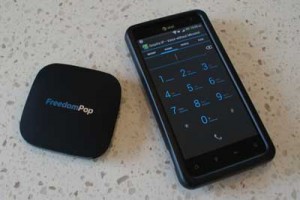How we saved $120 on our monthly cell phone bill
 At some point in the year 2007 I was kicking back watching a flickering image on a bulky CRT television when a breathtaking commercial appeared on the screen.
At some point in the year 2007 I was kicking back watching a flickering image on a bulky CRT television when a breathtaking commercial appeared on the screen.
It was for a product called an “iPhone” and after viewing the ad I unfortunately spent the rest of the evening in the hospital seeking medical help for my four-hour erection.
For years I’d heard that Apple was developing a phone, but that alone didn’t prepare me for watching two fingers zoom in on a digital map. Life would never be the same. My once-amazing Motorola Razr blinked at me softly in the same way a pet might look at its owner before taking one sad, final drive to the vet.
Fortunately for my little Razr, I had at least enough willpower to hold off on buying that first generation iPhone. I’ve been around Apple products for long enough to know that they always hold back some must-have features for later generations. I also have been well aware how overpriced they can be. So I held off as long as I could while the days of my T-Mobile contract ticked down.
When the iPhone 3 was announced, I knew it was time. I was out of contract finally and the latest iPhone awaited. My wife and I hopped into her car to head to the AT&T store to surrender to the irresistible siren call of unlimited data and a full internet experience on a portable device.
With shiny new phones iPhones in hand, mine in black, hers in white, we proudly strode back to her car, excited to try out the new device. I literally watched the dot on the digital map as it moved in real-time all the way home. I spent days ruining my vision discovering new apps and exploring the world through this magical device.
My love for my iPhone waned when Apple pushed out the 4.0 iOS update to my phone, rendering it nearly useless. It devoured the battery within minutes of standby and it would take 3-4 seconds for a character to appear on-screen after being touched. The phone was basically dead. And we were furious that Apple would screw over their own customers like that.
So we trudged down to the AT&T store and bought new phones. We were allowed to retain our unlimited data package if we signed a new contract. Still angry with Apple, I got a new Android phone and my wife got a new Windows phone. And things were OK. I mean it bugged us how much our family plan cost, but what are you going to do, right?
Well, when I finally left my crappy corporate job last year to get ready for Pretired Baby, we wanted to tighten up our finances everywhere we could, but we still had quite a bit of time left on our two-year contract. It didn’t seem we had much choice but to wait.
Our perspective changed, however, when my wife recently got a new job. A job that came with an employer-paid brand-new iPhone. I decided to take the plunge and go for the cheapest possible cell phone plan I could.
Unlike when I was working as a big-shot, always-on, digital marketing genius, I no longer needed to have absolutely reliable cell phone data. I needed a smart phone, yes. I conduct most of my consulting work via email and my clients demand near-instant responses. And, let’s be honest: Once you’ve had a taste of life with a smartphone there is no going back.
I also needed to be able to make reliable outbound cell phone calls when needed now that we have no home phone line. With a baby in the house, 911 access is critical.
What I no longer needed was “unlimited data.” Nor do I need unlimited texting or a large number of minutes.
So in summary, my requirements:
- Some sort of data package
- Ability to make outbound calls reliably
- Cost as low as possible
- And I didn’t want to buy a new device
After doing quite a bit of research on the various options out there, I decided to try something pretty radical: Combine a very cheap monthly cell plan with a “free” mobile internet device. All of this built on a foundation of Google Voice.
Here’s how it works.
- I transferred my phone number to GoogleVoice and make all my calls through that now.
- I signed up for a $10/month prepaid plan from AirVoice Wireless. This plan comes with 250 minutes for 30 days of service. You can set it up with an auto-replenish so it essentially acts as a contract plan (with no contract).
- Combine that package with a Freedom Spot Photon 4G Mobile Hotspot (Black)
*, a small WiFi box that becomes my data package. The FreedomPop deal is interesting. I paid $95.99 for the device and get 500MB per month at no additional cost. I justified this purchase because I actually have long-needed a way to have cheap, handy WiFi available when I use my laptop or iPad in client meetings.
It took a few weeks to get everything dialed in and I have it working OK now, although I’m still tweaking the set-up all the time. It’s important to note that if it’s absolutely critical that you have reliable phone service, this set-up is not for you. It’s also not for anyone who doesn’t have the time or stubbornness to make it work.
Critical apps to make a lower cell phone bill possible
I needed a few Android Apps for this to function well. Here’s what I’m using right now:
- Google Voice App – You make the majority of your adjustments to Google Voice actually through the web-based system, but you’ll still want to get the App. I think the App is actually better for iPhone than for Android for whatever reason. With Android, you can set it up so the phone asks you if you want to make a call with Google Voice or via the cell phone. I find it a little hacky. However, I’m currently doing all texting via the Google Voice App and it works pretty well.
- Groove IP – This app substitutes for the Google Voice App for making and receiving calls. I first tried TalkaTone based on some opinion I read online, but the voice quality was terrible (a lot of delays and cross-talk) and the interface was very poorly designed. Groove IP felt almost like any other phone and the voice quality has been outstanding. Unfortunately there are some problems (see below).
- WiFi Priority – This app is allows you to set WiFi priority dynamically so that the phone connects to various WiFi signals in the order you determine. This is important so I don’t use up my FreedomPop data allocation while I’m at home. It also saves me from having to constantly adjust settings on the phone or remember to turn off the FreedomPop. Occasionally it doesn’t switch correctly and I have to manually connect. Not sure what’s causing that, but it definitely is not 100% reliable.
- Group Ringtones – Not strictly necessary to this structure, but a nice enhancement, Group Ringtones lets you adjust ringtones based on who is calling — but group based, not individually based. My main use for this has been to set up a spam contact group so that I didn’t have to deal with all the spam calls that I started getting on my new AirVoice number (more below).
Now this set-up only works because of one important fact that cell phone providers don’t want you to think about: You have WiFi available almost anywhere you need your phone these days. Think about the two places most people will be using their phone: 1) Home 2) Work. In both places most will have WiFi available. That leaves a very small number of available hours where you have no WiFi. Those are the only times where it may make sense to pay for a data plan.
The Savings
Our bill to the bloodsuckers at AT&T was $130/month. Since my wife’s phone is now completely covered by work, her half was taken care of. That left my $65. Plus we had a cancellation fee to the dicks at AT&T and that was $346.
So expenses were $462 to get set up: the cost of the FreedomPop, a Google Voice activation fee, plus the AT&T cancellation fee. I also bought a few apps to make the system run smoothly, maybe $6 total. And, of course there is the $10/month AirVoice expense. So we should break even in 3-4 months, about three months ahead of our contract expiration so the total savings will be around $340 by breaking our contract early. Ongoing, we will have another $120/month in our pockets. If we took my wife’s surprise free phone service out of the mix, the savings would be just my half — just $55/month. I’d have to wait a full six months to break even, about when my contract would be up. But since we did have the free phone from her work, it made sense to try this a little earlier than I otherwise would have.
The problems
Unfortunately the story doesn’t end there. I’ve been testing this set-up for a month or so and it’s not without its pitfalls. To be fair to all of the companies involved, they weren’t designed for this. This hack is pretty extreme and is, in fact, pretty shaky. So shaky that once I reach the break-even point in a few months, I’m going to probably give it up for something a little more expensive. Issues I’ve found are:
- The FreedomPop is the weakest link in the chain. Hey, it’s free, what do you expect? Most importantly, the coverage map is extremely limited. This was my concern before I bought it but not being able to find any info out there I decided to give it a try. What I found is whenever I leave the main urban core, the signal disappears. This is not a worry from the perspective of making an emergency call since that’s what the AirVoice is for. However, this renders the map function useless (kinda important when you’re on the road) as well as any other data. No texting anyone that you’ll be late, no checking email, no looking up an address. No checking traffic reports.
- I’ve been experiencing a lot of crashes with the Groove IP app. They’ve been so random it’s been hard to figure out what’s causing them. Also annoying is that I sprung for the paid app, but the free version had actually been much more stable. I’m not sure what to make of that, but I’m hoping for an update soon.
- My phone has dropped a lot of calls, apparently because of a “feature” that turns off the WiFi when the screen goes black. I was able to change that setting but unfortunately that in turn causes poor battery life.
- It’s fairly slow reconnecting to Google Voice as I switch between networks. In fact Groove IP often won’t connect to Google Voice at all until I restart the phone. Sometimes I have to restart the FreedomPop as well (or instead of). In general maintaining a reliable connection to Google Voice just isn’t happening. I’ve never spent more time restarting and checking things. I’m constantly checking for the Groove IP icon to make sure I’m connected (in itself problematic as that indicator is not always reliable.
- Once I got a new AirVoice number, I started getting spam calls almost immediately. I quickly learned to never answer that number unless I recognized the caller, but occasionally I forget and answer it on instinct. Apparently having a prepaid number labels you as a poor person because the calls I’ve been getting and in-app ads are for things like immigration services and debt reduction services.
So, in short, I’m going to keep testing and saving for awhile longer, but I need more reliability than I’m getting. I know I can get some minimal data for at least $35/month at AirVoice, but $10 sounds so much better! I’ll be sure to keep you updated as I continue my quest to lower my cell phone bill. Other alternatives are Republic Wireless,* which looks VERY appealing and is exactly what the industry needs, but I don’t particularly want to buy a new phone, when my current one works great. Other good options include payLo by Virgin Mobile*, Net 10 Wireless*, Straight Talk Wireless* or PagePlus. Since these are no-contract plans, I may give a few of them a go and let you know how they work out.
The really good news is that Google Voice combined with cheap monthly data options (and the spread of public WiFi) are quickly dismantling the cell phone providers’ overpriced billing structures. I fully expect the average price for a monthly cell phone bill to drop to $20-$30 in 2-3 years.
The only thing I know for sure right now is I’ll never be trapped in another two-year contract again.
UPDATE 8/23/13: Still using this configuration but things have smoothed out quite a bit. The FreedomPop is still the weak link in the set-up so reliable incoming phone access outside the main urban area is nonexistent. However, the GrooveIP software has been working a bit better lately. My main complain right now when I stay within the city core is the switching between my home WiFi and the FreedomPop. It takes awhile to find the connection and sometimes the GrooveIP seems to just give up even though the WiFi is connected. I’ve missed a few calls after returning home from an outing because the GrooveIP lost its connection when I came into the house (as the phone correctly switched the higher-priority WiFi), but it never connected again. Therefore I frequently have to connect manually just to make sure it’s ready to receive calls. Once in awhile I’ll have to do a full reboot of the phone to clear everything out to get it to connect up properly. So, overall, still pretty sketchy, but it’s easy to see that as the technology catches up, this will be the default for all phones. I’m going to give it awhile longer before I seek out a more reliable data connection, but I’ll be keeping my Google Voice foundation for the foreseeable future.
Update 10/4/13: Good overview of using Google Voice via a computer here. If that would work for your lifestyle, that will get you to $0 per month!
Update 1/31/14: Be sure to head over and see the update to this story: The latest on my quest to reduce my cell phone bill
*Affiliate link




